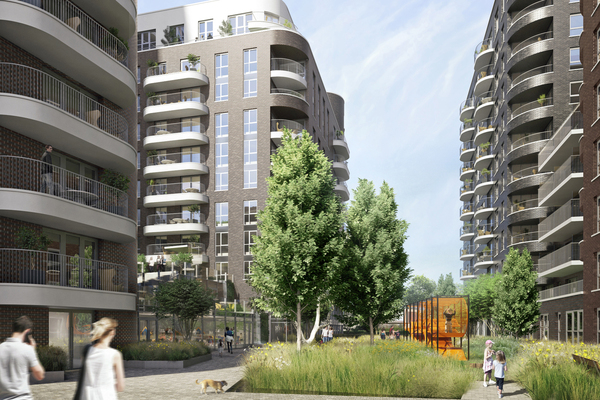North vs South: the great funding divide
Despite the rhetoric around the Northern Powerhouse, the North of England seems to be missing out on funding that could help deliver more homes. Luke Barratt finds out why housing’s geographical divide is as acute as ever. Illustration by Oivind Hovland
From George Osborne’s 2014 speech announcing the concept, to Boris Johnson’s recent high-vis trip to Manchester, Conservative politicians have spent the past five years talking up the ‘Northern Powerhouse’.
As a plan to boost economic growth in the North of England, it has generally focused on transport, science and devolution. But those in the social housing sector will know well the importance of bricks and mortar when it comes to making an area thrive.
Therefore, many in the North were disappointed in October last year when the Ministry of Housing, Communities and Local Government (MHCLG) announced a new formula to decide how funding for housing would be allocated.
This formula, according to analysis by lobbying group Key Cities, systematically disadvantages Northern areas. But how does it work? In what ways are these areas missing out? And why is Westminster doing this while it simultaneously insists on the importance of the North?
The method applies to the £4.6bn Housing Infrastructure Fund’s (HIF) forward funding, the £290m Estate Regeneration Fund, the £4.5bn Home Building Fund, the £630m Small Sites Fund, and the £1.3bn Land Assembly Fund.
Under the formula, 80% of these funds will be directed towards areas with ‘highest affordability pressure’, which is defined using the Office for National Statistics’ (ONS) figure for the ratio of median house prices to median workplace-based household income figures.
This sounds fairly harmless. After all, why shouldn’t the government prioritise less affordable areas?
But the actual results of this formula are more worrying. Of the 164 local authorities where housing is deemed to be unaffordable, only four – Harrogate, Trafford, Ryedale and Hambleton – are in the North. By contrast, out of the 161 local authorities considered affordable, 68 are in the North.
To be totally clear, this means a number of local authorities skewed towards the South of England have access to a pool of funding worth just over £9bn, while an almost equal number of local authorities skewed towards the North have access to just £2.2bn from those same funds.
Tracy Harrison, chief executive of the Northern Housing Consortium, describes this as “a crude measure”.
She adds: “Although relative to the South, [the North is affordable] in terms of house prices. That’s mirrored to a certain extent by low income levels and lower wealth. So it’s not taking account of that.”
To see how the formula works in practice, Inside Housing has analysed ONS figures and information from all the combined authorities to have submitted bids for the £4.6bn HIF forward funding pot, which pays for infrastructure projects that will unlock new homes.
This analysis has shown a clear divide between the North and South, with Northern areas that have applied for the fund having access to a far smaller pool of funding than Southern areas.
Bids for the HIF forward funding are submitted by combined authorities, while the ONS records affordability by local authority, so Inside Housing has recorded HIF projects under the local authority in which they will ultimately be built.
In some cases, projects span multiple authorities, but in all of these cases it made no difference to MHCLG’s formula which local authority was chosen because they were all in London, where every local authority is considered to have high affordability pressure.
The analysis divided the 44 combined authorities which bid for the funding into 61 local authorities and determined that 27 of those were not deemed to be under high affordability pressure and could therefore bid for only 20% of the pot, while 34 were deemed to be under high pressure and so could access the remaining 80%.
Thirteen Northern local authorities applied for funding. All of these were among the 27 considered not under pressure. This clearly shows MHCLG’s formula in action, making it harder for Northern authorities to access housing investment.
The 27 councils not deemed by MHCLG to be under high affordability pressure bid for £2.2bn but have access to just £920m.
The 34 councils which are deemed to be under high affordability pressure, on the other hand, bid for £4.1bn and have access to £3.7bn.
That means 90% of the funding requested by those councils is set to be provided by MHCLG. However, for the other group, which again is disproportionately made up of Northern authorities, MHCLG has set aside just 42% of the amount of money councils have asked for.
Bids from the four most ambitious local authorities in low-pressure areas amount to £1bn, meaning those four would not receive the funds they have asked for, even if the other 23 were all rejected entirely.
Interestingly, none of those four are actually in the North. Those projects are: a £330m plan to improve the M5 in Gloucestershire; a £250m package to, among other things in the area, build infrastructure to support the Commonwealth Games’ athletes’ village in Birmingham; a bid for £250m to enable housing between Bristol and Keynsham; and a £170m proposal to help regenerate a
waterfront in Medway, Kent.
These examples show how it is not just the North that is disadvantaged by MHCLG’s formula. Key cities Birmingham and Bristol are also not considered worthy of the bigger slice of the pie.
“Crude measures of affordability are backward-looking – they reflect historic market weaknesses”
Hugh Owen, director of strategy and public affairs, Riverside
However, on a regional basis, it is the North that suffers most. After all, there are plenty of other areas of the South East, the South West and the Midlands that do get access to that 80%. Remember, there are only four such areas in the North and none of them have applied to the HIF.
One HIF bid from a Northern authority has already been accepted. Carlisle City Council has secured £102m to build a link road which, it says, will enable the delivery of up to 10,000 new homes.
This means that the remaining 26 councils have access to just £818m. It is easily conceivable that none of the other 12 Northern councils receive any money from the HIF at all.
This would surely rankle in Wigan and Bolton, where the councils have launched a joint bid for £131.8m to build a network of new roads in the area.
It would be unlikely to go down well in Lancaster either, where the council wants £100m to build a bus rapid transit network and a dedicated cycle route between south Lancaster and the city centre, along with other improvements to address flood and drainage risks.
In all cases, Northern councils argue their plans will help deliver much-needed new homes, just as Southern councils do. But unless MHCLG’s formula is changed, they will not get the same shake of the stick.
MHCLG’s formula doesn’t apply to the Affordable Homes Programme, meaning housing associations don’t have to worry when agreeing strategic partnerships with Homes England, the government’s housing delivery agency.
However, there are other rules that disadvantage the North. In October 2017, Theresa May announced the £2bn return of government funding for social rented housing, but what she didn’t reveal until the following year was how it would be allocated.
George Osborne making a keynote speech at the Science and Industry Museum in Manchester, where he said that a new high-speed rail connection and better roads could create an economic “powerhouse” in the North of England to rival the success of London (picture: Press Association)
These funds, the government revealed in July last year, are limited to areas where private rents are £50 or more higher per week than social rents. This means that only 10 local authorities across the North are able to bid.
Ms Harrison says she is currently focusing on ensuring that, in the government’s upcoming Spending Review, the Affordable Homes Programme doesn’t get dragged into geographical targeting.
“What we’ve been doing,” she explains, “is starting to collect case studies from members that show how they’ve used the Affordable Homes Programme and how it’s facilitated innovative ways of addressing other social problems.”
The affordability formula is part of a wider story about how Westminster is putting less money into housing in the North of England.
According to research from Homes for the North, shared exclusively with Inside Housing, the share of UK public expenditure on housing targeted at the North over the past 20 years has reduced from 24% to 17.8%.
The report states: “Central government policies and programmes to facilitate housing development have entered a transitionary period.
“Without compensatory measures in the forthcoming Comprehensive Spending Review, it would appear the North will experience a further reduction in expenditure share from housing and infrastructure programmes which will become progressively more obvious as pre-existing budgets are expended.”
MHCLG argues that if its formula disadvantages Northern areas, that is simply because areas in the North aren’t in the same dire housing need as areas in the South. “We want to ensure funding reaches the areas where homes are hardest to afford,” adds a spokesperson for the department.
Hugh Owen, director of strategy and public affairs at the housing association Riverside, says this misses the point.
“Crude measures of affordability are backward-looking,” he tells Inside Housing. “They reflect historic market weaknesses. The North was slow to recover from the recession, for example. The North has got an oversupply of some types of inappropriate housing stock, which previous regeneration programmes have dealt with but there’s nothing there now.”
“We need to have far more local involvement in having an influence on how the government targets its money”
Judith Blake, leader, Leeds City Council
To fulfil the Northern Powerhouse’s aim to rebalance the economy, Mr Owen says, the government needs to have more of a transformational approach to housing in the North.
“MHCLG doesn’t really have an overt spatial strategy for its investment, but it has a covert one,” Mr Owen comments. “There are consequences of applying relatively crude measures as a methodology for distributing funding. Those consequences don’t necessarily align with other government policy.
“We think those things need to be properly aligned. If government is serious about the rebalancing agenda, it needs to line its ducks up. It needs to have a spatial investment strategy that reflects much broader strategies around investment in infrastructure and economic development etc.”
Judith Blake, leader of Leeds City Council, gives some idea of the scale of ambition needed, telling Inside Housing: “We have an estimate of 50,000 new homes needed a year to match demand and support the economic growth of the Northern Powerhouse. That’s particularly based on the economic review that we undertook some years ago.
“The lack of ability through the way the funding’s targeted to recognise the potential, I think, is the issue that we’re really concerned about.”
Leeds City Region, in fact, is the area in the North with the most projected dwellings required, according to another Homes for the North research paper published this month, with 1.7 million homes needed by 2050.
Ms Blake says the solution is more devolution. She adds: “We need to have far more local involvement in having an influence on how the government targets its money.”
Whatever the way around it, most people involved in housing in the North will be keen to see the back of these geographical targeting measures.
With the government’s Spending Review imminent, all eyes will be on the chancellor to see if words around the Northern Powerhouse translate into action.













